Effect of Different Mechanical Fans on Virus Particle Transport: A Review
Abstract
1. Introduction
2. Methods
2.1. Literature Collection
2.2. Screening
- Duplicate publications were excluded.
- Articles not written in English, those for which the full text was inaccessible, or papers available only in unpublished form were excluded.
- Publications unrelated to “fans and virus transmission” were excluded. Specifically, studies focusing on various types of ventilation strategies aimed at mitigating virus transmission were distinguished.
- The focus was on rotating fan ventilation strategies rather than internal fans, such as those found in air conditioners, fan coils, or non-rotating blade-only fans.
3. Role of Ceiling Fans in Airborne Viral Infection Control
3.1. Downward-Rotating Ceiling Fans
3.1.1. Principles and Effects of Downward-Rotating Ceiling Fans
3.1.2. Factors Affecting Virus Removal by Ceiling Fans
Coupled Effect of Rotational Speed and Particle Diameter
Coupled Effects of Rotational Speed and Particle Concentration
3.1.3. Effect of Ventilation on the Role of Ceiling Fans
High-Positioned Air Supply and Low-Positioned Air Supply Ventilation
Low-Positioned Air Supply and High-Positioned Air Return Ventilation
3.2. Upward-Rotating Ceiling Fans
3.2.1. Principles and Effects of Upward-Rotating Ceiling Fans
3.2.2. Upward-Rotating Fan Combination Applications
4. Role of Exhaust Fans in Airborne Viral Infection Control
4.1. Principles and Effects of Exhaust Fans
4.1.1. Exhaust-Fan-Dominated Airflow Patterns
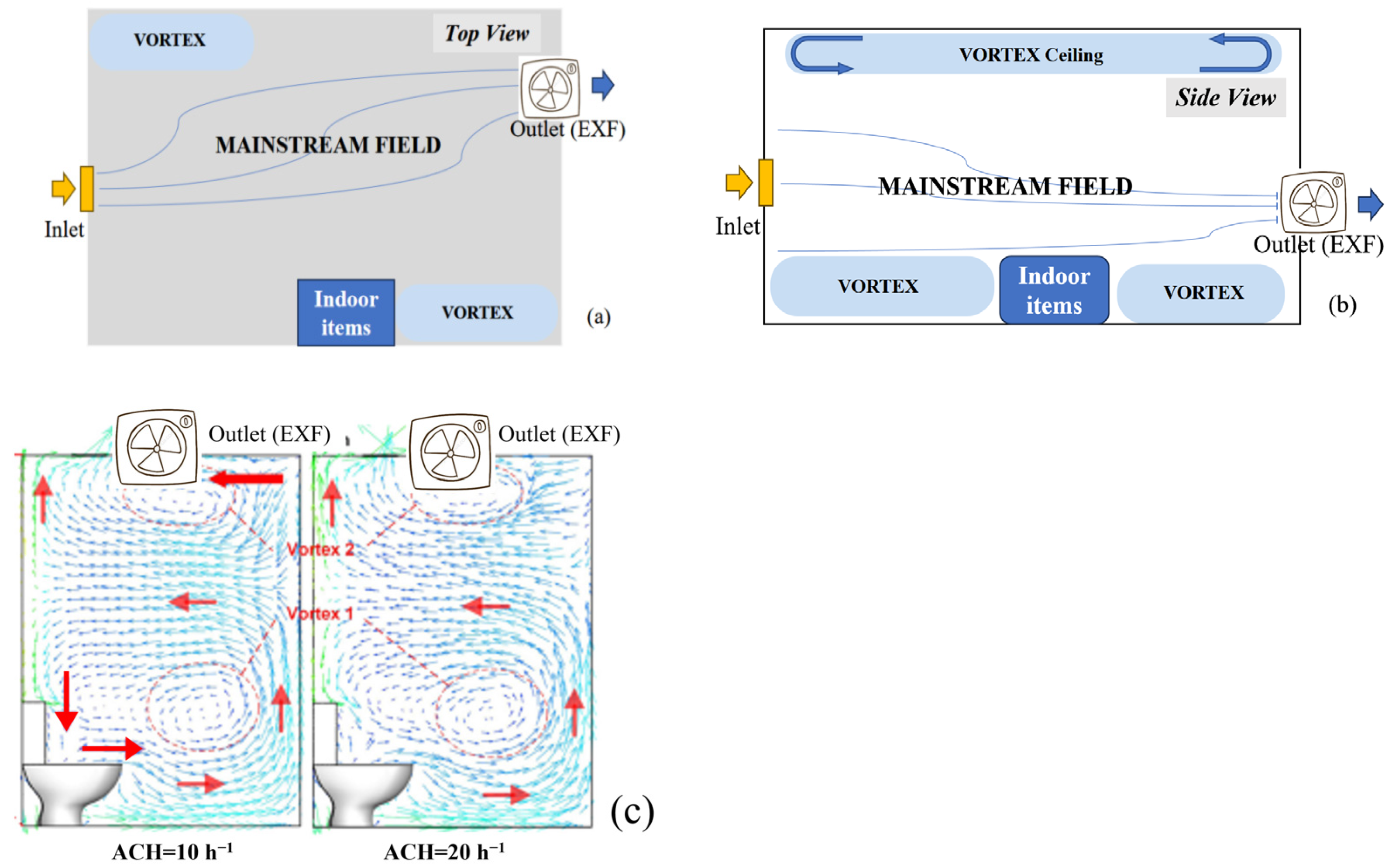
4.1.2. Exhaust-Fan-Assisted Airflow Patterns
4.1.3. Ability of Exhaust Fans to Control the Spread of Viruses
4.2. Time Until Exhaust Fans Emit Virus Particles
4.2.1. Relationship with the Building Layout
4.2.2. Relationship with Speed
4.2.3. Relationship with Environmental Factors
5. Role of Air-Apply Fans in Airborne Viral Infection Control
5.1. Airflow Patterns and Virus Removal Principles
5.2. Virus Removal Effect
6. Role of Other Fans in Airborne Viral Infection Control
6.1. Desk and Pedestal Fans
6.2. Multiple Types of Fan Cross Actions
7. Future Work
8. Conclusions
Author Contributions
Funding
Data Availability Statement
Conflicts of Interest
References
- Yan, S.; Wang, L.L.; Birnkrant, M.J.; Zhai, J.; Miller, S.L. Evaluating SARS-CoV-2 airborne quanta transmission and exposure risk in a mechanically ventilated multizone office building. Build. Environ. 2022, 219, 109184. [Google Scholar] [CrossRef] [PubMed]
- Sun, C.; Zhai, Z. The efficacy of social distance and ventilation effectiveness in preventing COVID-19 transmission. Sustain. Cities Soc. 2020, 62, 102390. [Google Scholar] [CrossRef] [PubMed]
- Fan, M.; Fu, Z.; Wang, J.; Wang, Z.; Suo, H.; Kong, X.; Li, H. A review of different ventilation modes on thermal comfort, air quality and virus spread control. Build. Environ. 2022, 212, 108831. [Google Scholar] [CrossRef] [PubMed]
- Bulfone, T.C.; Malekinejad, M.; Rutherford, G.W.; Razani, N. Outdoor transmission of SARS-CoV-2 and other respiratory viruses: A systematic review. J. Infect. Dis. 2021, 223, 550–561. [Google Scholar] [CrossRef] [PubMed]
- Morawska, L.; Tang, J.W.; Bahnfleth, W.; Bluyssen, P.M.; Boerstra, A.; Buonanno, G.; Cao, J.; Dancer, S.; Floto, A.; Franchimon, F.; et al. How can airborne transmission of COVID-19 indoors be minimised? Environ. Int. 2020, 142, 105832. [Google Scholar] [CrossRef] [PubMed]
- Zhang, R.; Li, Y.; Zhang, A.L.; Wang, Y.; Molina, M.J. Identifying airborne transmission as the dominant route for the spread of COVID-19. Proc. Natl. Acad. Sci. USA 2020, 117, 14857–14863. [Google Scholar] [CrossRef]
- Gao, Y.; Zhang, H.; Arens, E.; Present, E.; Ning, B.; Zhai, Y.; Pantelic, J.; Luo, M.; Zhao, L.; Raftery, P.; et al. Ceiling fan air speeds around desks and office partitions. Build. Environ. 2017, 124, 412–440. [Google Scholar] [CrossRef]
- Ferrari, S.; Blázquez, T.; Cardelli, R.; Puglisi, G.; Suárez, R.; Mazzarella, L. Ventilation strategies to reduce airborne transmission of viruses in classrooms: A systematic review of scientific literature. Build. Environ. 2022, 222, 109366. [Google Scholar] [CrossRef]
- Onmek, N.; Kongcharoen, J.; Singtong, A.; Penjumrus, A.; Junnoo, S. Environmental factors and ventilation affect concentrations of microorganisms in hospital wards of Southern Thailand. J. Environ. Public Health 2020, 2020, 7292198. [Google Scholar] [CrossRef] [PubMed]
- Cheung, T.; Li, J.; Goh, J.; Sekhar, C.; Cheong, D.; Tham, K.W. Evaluation of aerosol transmission risk during home quarantine under different operating scenarios: A pilot study. Build. Environ. 2022, 225, 109640. [Google Scholar] [CrossRef]
- Liang, C.; Li, X.; Shao, X.; Li, B. Direct relationship between the system cooling load and indoor heat gain in a non-uniform indoor environment. Energy 2020, 191, 116490. [Google Scholar] [CrossRef]
- Li, W.; Chong, A.; Hasama, T.; Xu, L.; Lasternas, B.; Tham, K.W.; Lam, K.P. Effects of ceiling fans on airborne transmission in an air-conditioned space. Build. Environ. 2021, 198, 107887. [Google Scholar] [CrossRef]
- Qiu-Wang, W.; Zhen, Z. Performance comparison between mixing ventilation and displacement ventilation with and without cooled ceiling. Eng. Comput. 2006, 23, 218–237. [Google Scholar] [CrossRef]
- Sun, S.; Li, J.; Han, J. How human thermal plume influences near-human transport of respiratory droplets and airborne particles: A review. Environ. Chem. Lett. 2021, 19, 1971–1982. [Google Scholar] [CrossRef] [PubMed]
- Lin, Y.; Tsai, T. An experimental study on a full-scale indoor thermal environment using an Under-Floor Air Distribution system. Energy Build. 2014, 80, 321–330. [Google Scholar] [CrossRef]
- Bamdad, K.; Cholette, M.E.; Guan, L.; Bell, J. Ant colony algorithm for building energy optimisation problems and comparison with benchmark algorithms. Energy Build. 2017, 154, 404–414. [Google Scholar] [CrossRef]
- Alexi, A.; Rosenfeld, A.; Lazebnik, T. The Trade-Off between Airborne Pandemic Control and Energy Consumption Using Air Ventilation Solutions. Sensors 2022, 22, 8594. [Google Scholar] [CrossRef]
- Zaniboni, L.; Albatici, R. Natural and mechanical ventilation concepts for indoor comfort and well-being with a sustainable design perspective: A systematic review. Buildings 2022, 12, 1983. [Google Scholar] [CrossRef]
- Park, S.; Choi, Y.; Song, D.; Kim, E.K. Natural ventilation strategy and related issues to prevent coronavirus disease 2019 (COVID-19) airborne transmission in a school building. Sci. Total Environ. 2021, 789, 147764. [Google Scholar] [CrossRef] [PubMed]
- Ren, C.; Cao, S.-J.; Haghighat, F. A practical approach for preventing dispersion of infection disease in naturally ventilated room. J. Build. Eng. 2022, 48, 103921. [Google Scholar] [CrossRef]
- Cavalerie, A.; Gosselin, L. Analysis of window opening in arctic community housing and development of data-driven models. Build. Environ. 2024, 258, 111582. [Google Scholar] [CrossRef]
- Moghadam, T.T.; Morales, C.E.O.; Zambrano, M.J.L.; Bruton, K.; O’Sullivan, D.T. Energy efficient ventilation and indoor air quality in the context of COVID-19-A systematic review. Renew. Sustain. Energy Rev. 2023, 182, 113356. [Google Scholar] [CrossRef] [PubMed]
- Shah, N.; Sathaye, N.; Phadke, A.; Letschert, V. Efficiency improvement opportunities for ceiling fans. Energy Effic. 2015, 8, 37–50. [Google Scholar] [CrossRef]
- Schmidt, K.; Patterson, D.J. Performance results for a high efficiency tropical ceiling fan and comparisons with conventional fans: Demand side management via small appliance efficiency. Renew. Energy 2001, 22, 169–176. [Google Scholar] [CrossRef]
- Letschert, V.; McNeil, M.; Zhou, N.; Sathaye, J. Residential and Transport Energy Use in India: Past Trend and Future Outlook; Lawrence Berkeley National Lab. (LBNL): Berkeley, CA, USA, 2009. [Google Scholar]
- Liu, S.; Lipczynska, A.; Schiavon, S.; Arens, E. Detailed experimental investigation of air speed field induced by ceiling fans. Build. Environ. 2018, 142, 342–360. [Google Scholar] [CrossRef]
- Mosovsky, J.A. Sulfur Hexaflouride Tracer Gas Evaluations on Hood Exhaust Reductions. Am. Ind. Hyg. Assoc. J. 1995, 56, 44–49. [Google Scholar] [CrossRef]
- Wan, J.; Zhang, W.; Zhang, W. An energy-efficient air-conditioning system with an exhaust fan integrated with a supply fan. Energy Build. 2009, 41, 1299–1305. [Google Scholar] [CrossRef]
- Mehmood, K.; Shahzad, A.; Masud, J.; Akram, F.; Mumtaz, M.; Shams, T.A. Numerical analysis of bladeless ceiling fan: An effective alternative to conventional ceiling fan. J. Wind. Eng. Ind. Aerodyn. 2022, 221, 104905. [Google Scholar] [CrossRef]
- Bhandari, N.; Tadepalli, S.; Gopalakrishnan, P. Influence of non-uniform distribution of fan-induced air on thermal comfort conditions in university classrooms in warm and humid climate, India. Build. Environ. 2023, 238, 110373. [Google Scholar] [CrossRef]
- Kent, M.G.; Huynh, N.K.; Mishra, A.K.; Tartarini, F.; Lipczynska, A.; Li, J.; Sultan, Z.; Goh, E.; Karunagaran, G.; Natarajan, A.; et al. Energy savings and thermal comfort in a zero energy office building with fans in Singapore. Build. Environ. 2023, 243, 110674. [Google Scholar] [CrossRef]
- Omrani, S.; Matour, S.; Bamdad, K.; Izadyar, N. Ceiling fans as ventilation assisting devices in buildings: A critical review. Build. Environ. 2021, 201, 108010. [Google Scholar] [CrossRef]
- Zhang, Y.; Mo, J.; Li, Y.; Sundell, J.; Wargocki, P.; Zhang, J.; Little, J.C.; Corsi, R.; Deng, Q.; Leung, M.H.; et al. Can commonly-used fan-driven air cleaning technologies improve indoor air quality? A literature review. Atmos. Environ. 2011, 45, 4329–4343. [Google Scholar] [CrossRef]
- Piwowarski, M.; Jakowski, D. Areas of fan research—A review of the literature in terms of improving operating efficiency and reducing noise emissions. Energies 2023, 16, 1042. [Google Scholar] [CrossRef]
- Cao, G.; Awbi, H.; Yao, R.; Fan, Y.; Sirén, K.; Kosonen, R.; Zhang, J.J. A review of the performance of different ventilation and airflow distribution systems in buildings. Build. Environ. 2014, 73, 171–186. [Google Scholar] [CrossRef]
- Pandey, B.; Saha, S.K.; Banerjee, R. Effect of ceiling fan in mitigating exposure to airborne pathogens and COVID-19. Indoor Built Environ. 2023, 32, 1973–1999. [Google Scholar] [CrossRef]
- Yang, S.; Wang, L.L.; Raftery, P.; Ivanovich, M.; Taber, C.; Bahnfleth, W.P.; Wargocki, P.; Pantelic, J.; Zou, J.; Mortezazadeh, M.; et al. Comparing airborne infectious aerosol exposures in sparsely occupied large spaces utilizing large-diameter ceiling fans. Build. Environ. 2023, 231, 110022. [Google Scholar] [CrossRef]
- Zhu, S.; Srebric, J.; Rudnick, S.N.; Vincent, R.L.; Nardell, E.A. Numerical Modeling of Indoor Environment with a Ceiling Fan and an Upper-Room Ultraviolet Germicidal Irradiation System. Build. Environ. 2014, 72, 116–124. [Google Scholar] [CrossRef]
- Qian, H.; Li, Y.; Seto, W.; Ching, P.; Ching, W.; Sun, H. Natural ventilation for reducing airborne infection in hospitals. Build. Environ. 2010, 45, 559–565. [Google Scholar] [CrossRef]
- Schiavon, S.; Yang, B.; Donner, Y.; Chang, V.W.C.; Nazaroff, W.W. Thermal comfort, perceived air quality, and cognitive performance when personally controlled air movement is used by tropically acclimatized persons. Indoor Air 2017, 27, 690–702. [Google Scholar] [CrossRef] [PubMed]
- Habchi, C.; Ghali, K.; Ghaddar, N.; Chakroun, W.; Alotaibi, S. Ceiling personalized ventilation combined with desk fans for reduced direct and indirect cross-contamination and efficient use of office space. Energy Convers. Manag. 2016, 111, 158–173. [Google Scholar] [CrossRef]
- Xu, C.; Liu, W.; Luo, X.; Huang, X.; Nielsen, P.V. Prediction and control of aerosol transmission of SARS-CoV-2 in ventilated context: From source to receptor. Sustain. Cities Soc. 2022, 76, 103416. [Google Scholar] [CrossRef] [PubMed]
- Izadyar, N.; Miller, W. Ventilation strategies and design impacts on indoor airborne transmission: A review. Build. Environ. 2022, 218, 109158. [Google Scholar] [CrossRef] [PubMed]
- Rayegan, S.; Shu, C.; Berquist, J.; Jeon, J.; Zhou, L.G.; Wang, L.L.; Mbareche, H.; Tardif, P.; Ge, H. A review on indoor airborne transmission of COVID-19–modelling and mitigation approaches. J. Build. Eng. 2023, 64, 105599. [Google Scholar] [CrossRef]
- Franceschini, P.B.; Neves, L.O. A critical review on occupant behaviour modelling for building performance simulation of naturally ventilated school buildings and potential changes due to the COVID-19 pandemic. Energy Build. 2022, 258, 111831. [Google Scholar] [CrossRef]
- Bu, Y.; Ooka, R.; Kikumoto, H.; Oh, W. Recent research on expiratory particles in respiratory viral infection and control strategies: A review. Sustain. Cities Soc. 2021, 73, 103106. [Google Scholar] [CrossRef] [PubMed]
- Sadripour, S.; Mollamahdi, M.; Sheikhzadeh, G.A.; Adibi, M. Providing thermal comfort and saving energy inside the buildings using a ceiling fan in heating systems. J. Braz. Soc. Mech. Sci. Eng. 2017, 39, 4219–4230. [Google Scholar] [CrossRef]
- Wang, H.; Luo, M.; Wang, G.; Li, X. Airflow pattern induced by ceiling fan under different rotation speeds and blowing directions. Indoor Built Environ. 2019, 29, 1425–1440. [Google Scholar] [CrossRef]
- Pichurov, G.; Srebric, J.; Zhu, S.; Vincent, R.L.; Brickner, P.W.; Rudnick, S.N. A validated numerical investigation of the ceiling fan’s role in the upper-room UVGI efficacy. Build. Environ. 2015, 86, 109–119. [Google Scholar] [CrossRef]
- Jain, A.; Upadhyay, R.R.; Chandra, S.; Saini, M.; Kale, S. Experimental investigation of the flow field of a ceiling fan. In Heat Transfer Summer Conference; AMSE: Oak Ridge, TN, USA, 2004; Volume 4692, pp. 93–99. [Google Scholar] [CrossRef]
- Li, W.; Hasama, T.; Chong, A.; Hang, J.G.; Lasternas, B.; Lam, K.P.; Tham, K.W. Transient transmission of droplets and aerosols in a ventilation system with ceiling fans. Build. Environ. 2023, 230, 109988. [Google Scholar] [CrossRef]
- Zhu, S.; Kato, S.; Murakami, S.; Hayashi, T. Study on inhalation region by means of CFD analysis and experiment. Build. Environ. 2005, 40, 1329–1336. [Google Scholar] [CrossRef]
- Chen, W.; Zhang, H.; Arens, E.; Luo, M.; Wang, Z.; Jin, L.; Liu, J.; Bauman, F.S.; Raftery, P. Ceiling-fan-integrated air conditioning: Airflow and temperature characteristics of a sidewall-supply jet interacting with a ceiling fan. Build. Environ. 2020, 171, 106660. [Google Scholar] [CrossRef]
- Mihara, K.; Lasternas, B.; Takemasa, Y.; Tham, K.W.; Sekhar, C. Indoor environment evaluation of a Dedicated Outdoor Air System with ceiling fans in the tropics–A thermal manikin study. Build. Environ. 2018, 143, 605–617. [Google Scholar] [CrossRef]
- Liu, Y.; Ning, Z.; Chen, Y.; Guo, M.; Liu, Y.; Gali, N.K.; Sun, L.; Duan, Y.; Cai, J.; Westerdahl, D.; et al. Aerodynamic analysis of SARS-CoV-2 in two Wuhan hospitals. Nature 2020, 582, 557–560. [Google Scholar] [CrossRef]
- Li, H.; Leong, F.Y.; Xu, G.; Ge, Z.; Kang, C.W.; Lim, K.H. Dispersion of evaporating cough droplets in tropical outdoor environment. Phys. Fluids 2020, 32, 113301. [Google Scholar] [CrossRef]
- Benabed, A.; Boulbair, A.; Limam, K. Experimental study of the human walking-induced fine and ultrafine particle resuspension in a test chamber. Build. Environ. 2020, 171, 106655. [Google Scholar] [CrossRef]
- Mat, M.N.H.; Basir, F.M.; Yusup, E.M. Fans deactivation for minimisation of airborne pathogen transmission: During Malaysians congregational prayer gathering in mosque. Int. Commun. Heat Mass Transf. 2021, 129, 105694. [Google Scholar] [CrossRef]
- Bhagat, R.K.; Wykes, M.S.D.; Dalziel, S.B.; Linden, P.F. Effects of ventilation on the indoor spread of COVID-19. J. Fluid Mech. 2020, 903, F1. [Google Scholar] [CrossRef] [PubMed]
- Blocken, B.; van Druenen, T.; Ricci, A.; Kang, L.; van Hooff, T.; Qin, P.; Xia, L.; Ruiz, C.A.; Arts, J.; Diepens, J.; et al. Ventilation and air cleaning to limit aerosol particle concentrations in a gym during the COVID-19 pandemic. Build. Environ. 2021, 193, 107659. [Google Scholar] [CrossRef] [PubMed]
- Jiang, S.; Huang, L.; Chen, X.; Wang, J.; Wu, W.; Yin, S.; Chen, W.; Zhan, J.; Yan, L.; Ma, L.; et al. Ventilation of wards and nosocomial outbreak of severe acute respiratory syndrome among healthcare workers. Chin. Med. J. 2003, 116, 1293–1297. [Google Scholar]
- Luongo, J.C.; Fennelly, K.P.; Keen, J.A.; Zhai, Z.J.; Jones, B.W.; Miller, S.L. Role of mechanical ventilation in the airborne transmission of infectious agents in buildings. Indoor Air 2016, 26, 666–678. [Google Scholar] [CrossRef] [PubMed]
- Li, Y.; Leung, G.M.; Tang, J.W.; Yang, X.; Chao, C.Y.H.; Lin, J.Z.; Lu, J.W.; Nielsen, P.V.; Niu, J.; Qian, H.; et al. Role of ventilation in airborne transmission of infectious agents in the built environment-a multidisciplinary systematic review. Indoor Air 2007, 17, 2–18. [Google Scholar] [CrossRef]
- Ben-David, T.; Waring, M.S. Impact of natural versus mechanical ventilation on simulated indoor air quality and energy consumption in offices in fourteen US cities. Build. Environ. 2016, 104, 320–336. [Google Scholar] [CrossRef]
- Bhagat, R.K.; Linden, P. Displacement ventilation: A viable ventilation strategy for makeshift hospitals and public buildings to contain COVID-19 and other airborne diseases. R. Soc. Open Sci. 2020, 7, 200680. [Google Scholar] [CrossRef] [PubMed]
- Pantelic, J.; Tham, K.W. Adequacy of air change rate as the sole indicator of an air distribution system’s effectiveness to mitigate airborne infectious disease transmission caused by a cough release in the room with overhead mixing ventilation: A case study. HVAC&R Res. 2013, 19, 947–961. [Google Scholar] [CrossRef]
- Wang, H.-Q.; Huang, C.-H.; Liu, D.; Zhao, F.-Y.; Sun, H.-B.; Wang, F.-F.; Li, C.; Kou, G.-X.; Ye, M.-Q. Fume transports in a high rise industrial welding hall with displacement ventilation system and individual ventilation units. Build. Environ. 2012, 52, 119–128. [Google Scholar] [CrossRef]
- Berlanga, F.; de Adana, M.R.; Olmedo, I.; Villafruela, J.; José, J.S.; Castro, F. Experimental evaluation of thermal comfort, ventilation performance indices and exposure to airborne contaminant in an airborne infection isolation room equipped with a displacement air distribution system. Energy Build. 2018, 158, 209–221. [Google Scholar] [CrossRef]
- Alajmi, A.F.; Abou-Ziyan, H.Z.; El-Amer, W. Energy analysis of under-floor air distribution (UFAD) system: An office building case study. Energy Convers. Manag. 2013, 73, 78–85. [Google Scholar] [CrossRef]
- Zhu, S.; Srebric, J.; Rudnick, S.N.; Vincent, R.L.; Nardell, E.A. Numerical investigation of upper-room UVGI disinfection efficacy in an environmental chamber with a ceiling fan. Photochem. Photobiol. 2013, 89, 782–791. [Google Scholar] [CrossRef] [PubMed]
- Srivastava, S.; Zhao, X.; Manay, A.; Chen, Q. Effective ventilation and air disinfection system for reducing coronavirus disease 2019 (COVID-19) infection risk in office buildings. Sustain. Cities Soc. 2021, 75, 103408. [Google Scholar] [CrossRef]
- Park, S.; Mistrick, R.; Sitzabee, W.; Rim, D. Effect of ventilation strategy on performance of upper-room ultraviolet germicidal irradiation (UVGI) system in a learning environment. Sci. Total Environ. 2023, 899, 165454. [Google Scholar] [CrossRef] [PubMed]
- Noakes, C.J.; Sleigh, P.A.; Fletcher, L.A.; Beggs, C.B. Use of CFD modelling to optimise the design of upper-room UVGI disinfection systems for ventilated rooms. Indoor Built Environ. 2006, 15, 347–356. [Google Scholar] [CrossRef]
- Escombe, A.R.; Moore, D.A.J.; Gilman, R.H.; Navincopa, M.; Ticona, E.; Mitchell, B.; Noakes, C.; Martínez, C.; Sheen, P.; Ramirez, R.; et al. Upper-room ultraviolet light and negative air ionization to prevent tuberculosis transmission. PLoS Med. 2009, 6, e1000043. [Google Scholar] [CrossRef] [PubMed]
- First, M.; Rudnick, S.N.; Banahan, K.F.; Vincent, R.L.; Brickner, P.W. Fundamental factors affecting upper-room ultraviolet germicidal irradiation—Part I. Experimental. J. Occup. Environ. Hyg. 2007, 4, 321–331. [Google Scholar] [CrossRef] [PubMed]
- Rudnick, S.; McDevitt, J.; Hunt, G.; Stawnychy, M.; Vincent, R.; Brickner, P. Influence of ceiling fan’s speed and direction on efficacy of upperroom, ultraviolet germicidal irradiation: Experimental. Build. Environ. 2015, 92, 756–763. [Google Scholar] [CrossRef] [PubMed]
- Martínez-Espinosa, E.; Carvajal-Mariscal, I. Virus-laden droplet nuclei in vortical structures associated with recirculation zones in indoor environments: A possible airborne transmission of SARS-CoV-2. Environ. Adv. 2023, 12, 100376. [Google Scholar] [CrossRef] [PubMed]
- Sinha, K.; Yadav, M.S.; Verma, U.; Murallidharan, J.S.; Kumar, V. Effect of recirculation zones on the ventilation of a public washroom. Phys. Fluids 2021, 33, 117101. [Google Scholar] [CrossRef]
- Ansi/Ashrae/Ashe Standard 170–2017; Ventilation of Health Care Facilities. American Society of Heating, Refrigerating and Air- Conditioning Engineers, Inc.: Atlanta, GA, USA, 2017.
- Wang, J.-X.; Wu, Z.; Wang, H.; Zhong, M.; Mao, Y.; Li, Y.; Wang, M.; Yao, S. Ventilation reconstruction in bathrooms for restraining hazardous plume: Mitigate COVID-19 and beyond. J. Hazard. Mater. 2022, 439, 129697. [Google Scholar] [CrossRef]
- Khan, T.; Withers, C.; Martin, E.; Bonilla, N. Approaches for effective negative pressure isolation space control to minimize airborne transmission of contaminants in residential homes. Indoor Built Environ. 2022, 31, 1405–1417. [Google Scholar] [CrossRef]
- Saw, L.H.; Leo, B.F.; Lin, C.Y.; Mokhtar, N.M.; Ali, S.H.M.; Nadzir, M.S.M. The myth of air purifier in mitigating the transmission risk of SARS-CoV-2 virus. Aerosol Air Qual. Res. 2022, 22, 210213. [Google Scholar] [CrossRef]
- Tham, K.; Parshetti, G.; Balasubramanian, R.; Sekhar, C.; Cheong, D. Mitigating particulate matter exposure in naturally ventilated buildings during haze episodes. Build. Environ. 2018, 128, 96–106. [Google Scholar] [CrossRef]
- Wu, Y.; Niu, J. Assessment of mechanical exhaust in preventing vertical cross-household infections associated with single-sided ventilation. Build. Environ. 2016, 105, 307–316. [Google Scholar] [CrossRef]
- Gilkeson, C.; Camargo-Valero, M.; Pickin, L.; Noakes, C. Measurement of ventilation and airborne infection risk in large naturally ventilated hospital wards. Build. Environ. 2013, 65, 35–48. [Google Scholar] [CrossRef]
- Ayou, D.S.; Prieto, J.; Ramadhan, F.; González, G.; Duro, J.A.; Coronas, A. Energy Analysis of Control Measures for Reducing Aerosol Transmission of COVID-19 in the Tourism Sector of the “Costa Daurada” Spain. Energies 2022, 15, 937. [Google Scholar] [CrossRef]
- Biswas, R.; Pal, A.; Pal, R.; Sarkar, S.; Mukhopadhyay, A. Risk assessment of COVID infection by respiratory droplets from cough for various ventilation scenarios inside an elevator: An OpenFOAM-based computational fluid dynamics analysis. Phys. Fluids 2022, 34, 013318. [Google Scholar] [CrossRef] [PubMed]
- Pal, A.; Biswas, R.; Sarkar, S.; Mukhopadhyay, A. Effect of ventilation and climatic conditions on COVID-19 transmission through respiratory droplet transport via both airborne and fomite mode inside an elevator. Phys. Fluids 2022, 34, 083319. [Google Scholar] [CrossRef]
- Ma, J.; Qian, H.; Liu, F.; Sui, G.; Zheng, X. Exposure risk to medical staff in a nasopharyngeal swab sampling cabin under four different ventilation strategies. Buildings 2022, 12, 353. [Google Scholar] [CrossRef]
- Clegg, M.; Thornes, J.E.; Banerjee, D.; Mitsakou, C.; Quaiyoom, A.; Delgado-Saborit, J.M.; Phalkey, R. Intervention of an Upgraded Ventilation System and Effects of the COVID-19 Lockdown on Air Quality at Birmingham New Street Railway Station. Int. J. Environ. Res. Public Health 2022, 19, 575. [Google Scholar] [CrossRef]
- Makhoul, A.; Ghali, K.; Ghaddar, N. Desk fans for the control of the convection flow around occupants using ceiling mounted personalized ventilation. Build. Environ. 2013, 59, 336–348. [Google Scholar] [CrossRef]
- Bolashikov, Z.; Melikov, A.; Krenek, M. Control of the free convective flow around the human body for enhanced inhaled air quality: Application to a seat-incorporated personalized ventilation unit. HVAC&R Res. 2010, 16, 161–188. [Google Scholar] [CrossRef]
- Wang, W.; Kimoto, S.; Huang, R.; Matsui, Y.; Yoneda, M.; Wang, H.; Wang, B. Identifying the contribution of charge effects to airborne transmission of aerosols in confined spaces. Sci. Total Environ. 2022, 816, 151527. [Google Scholar] [CrossRef]
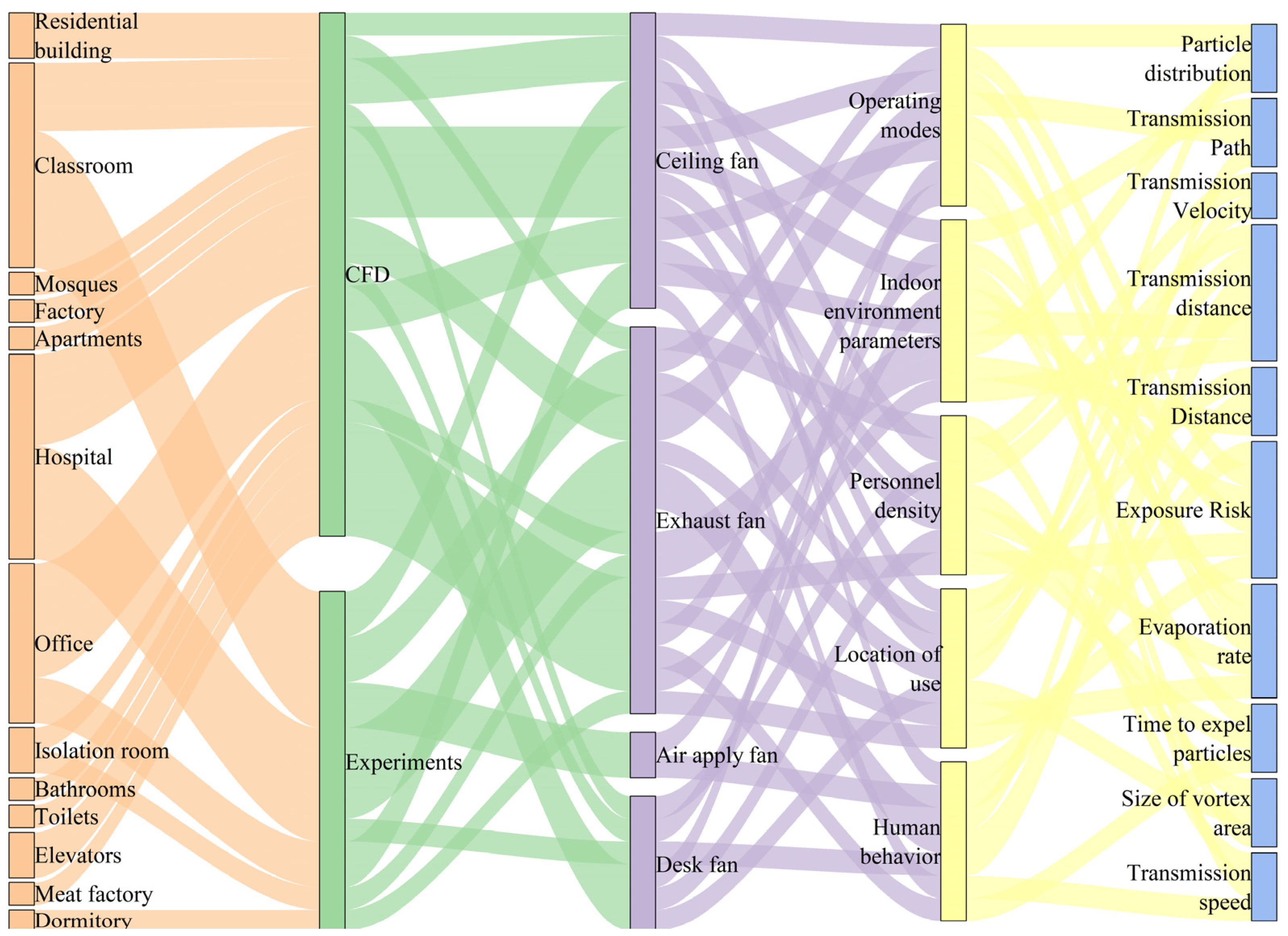
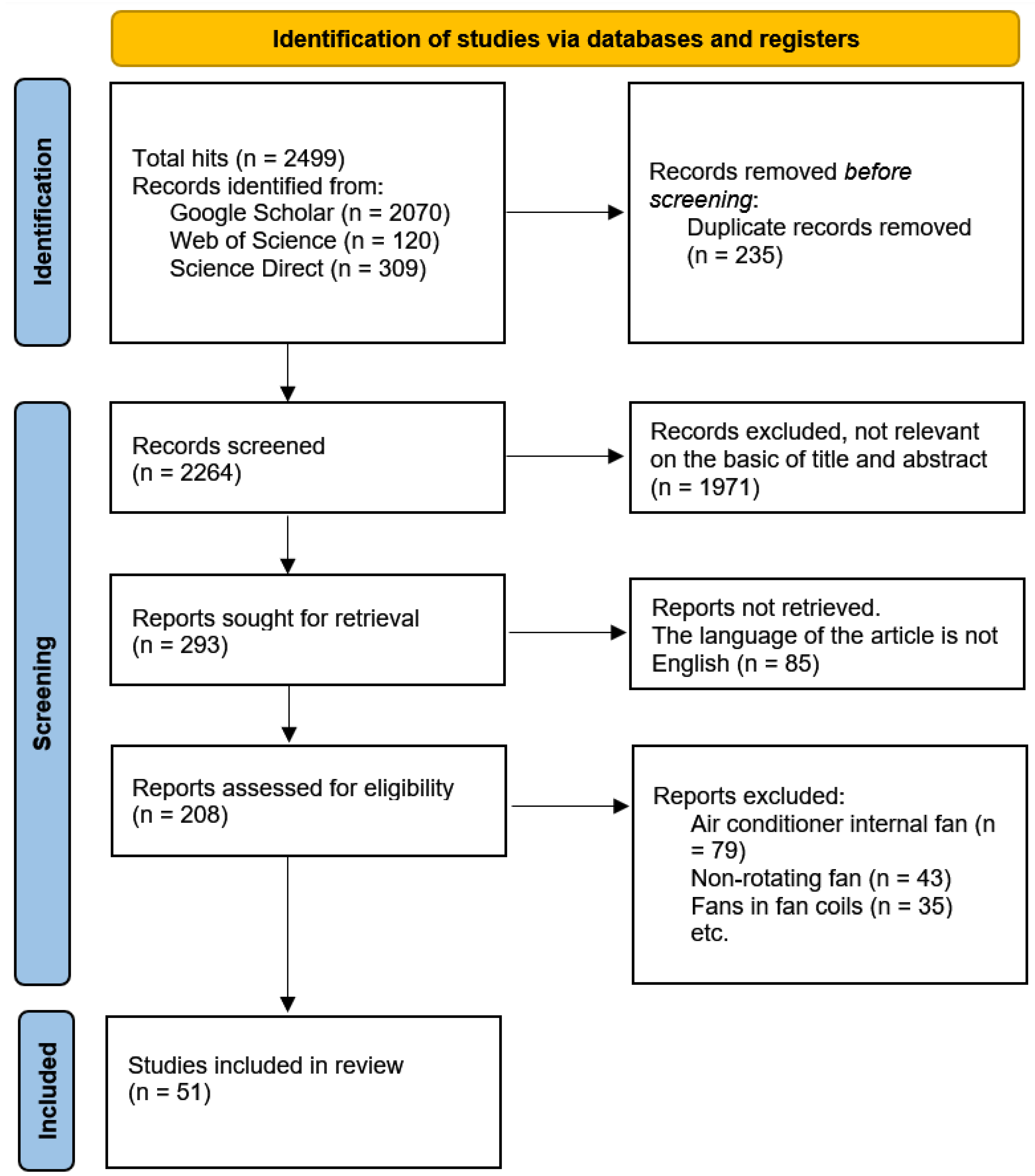
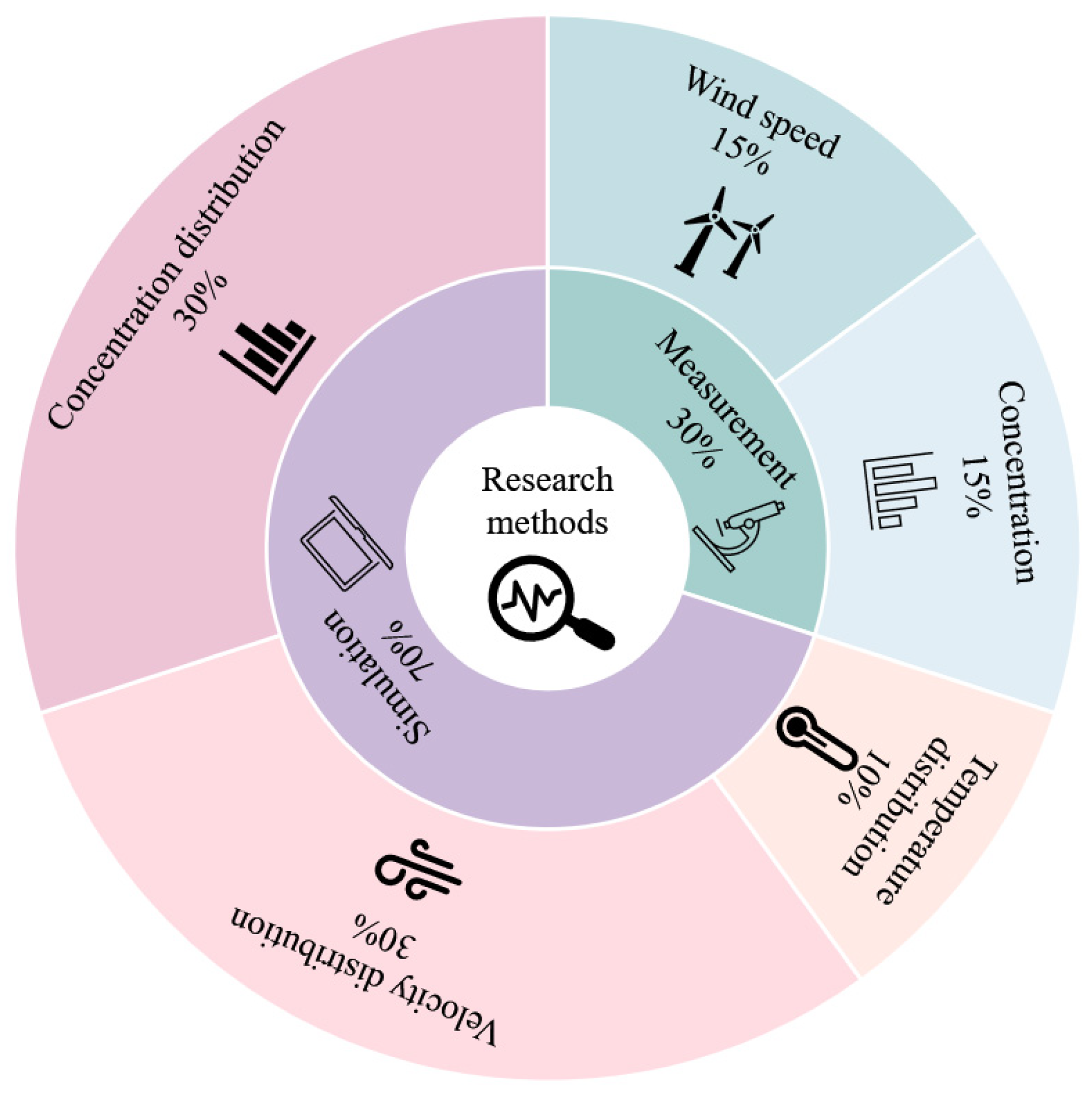
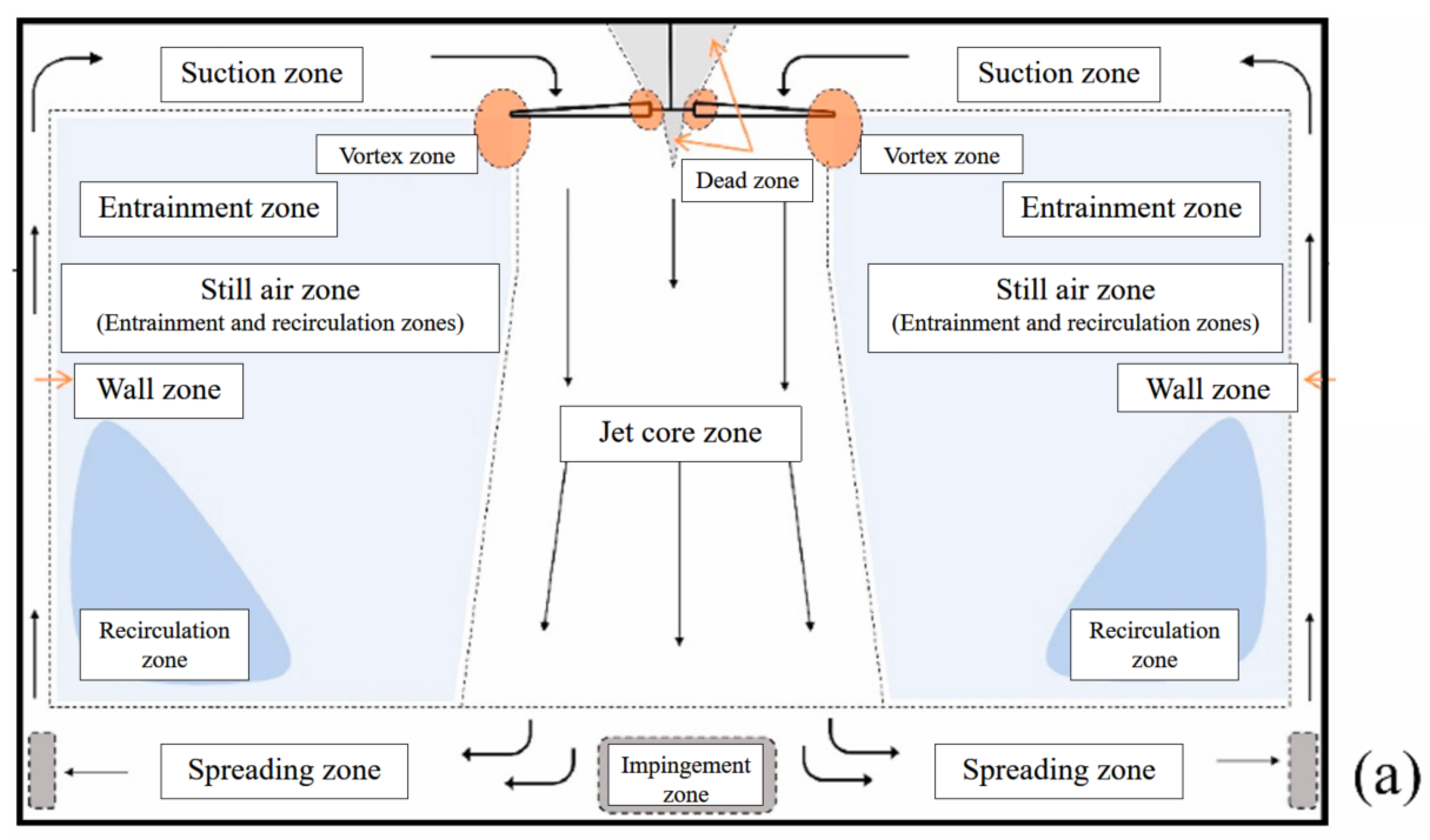


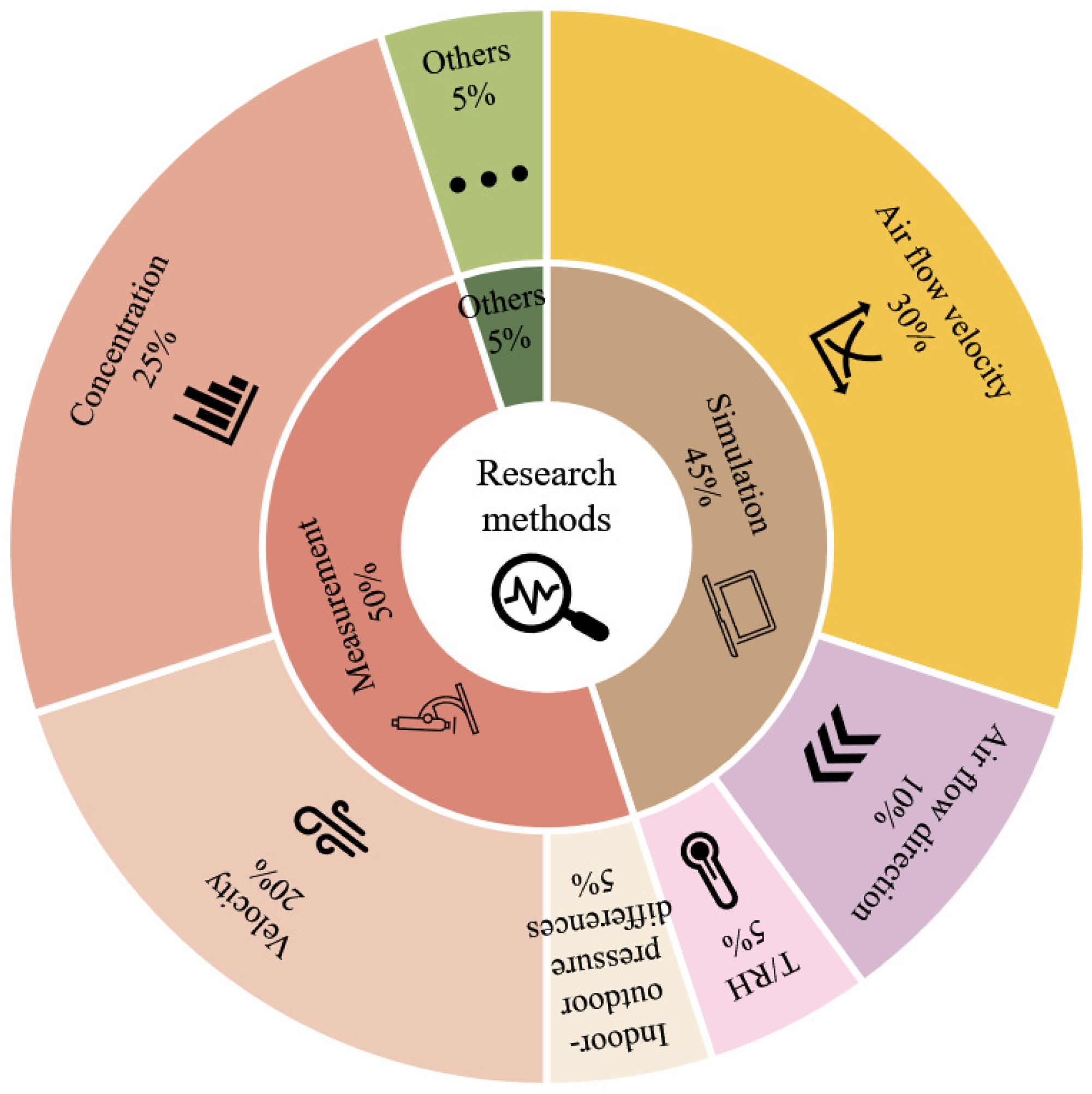

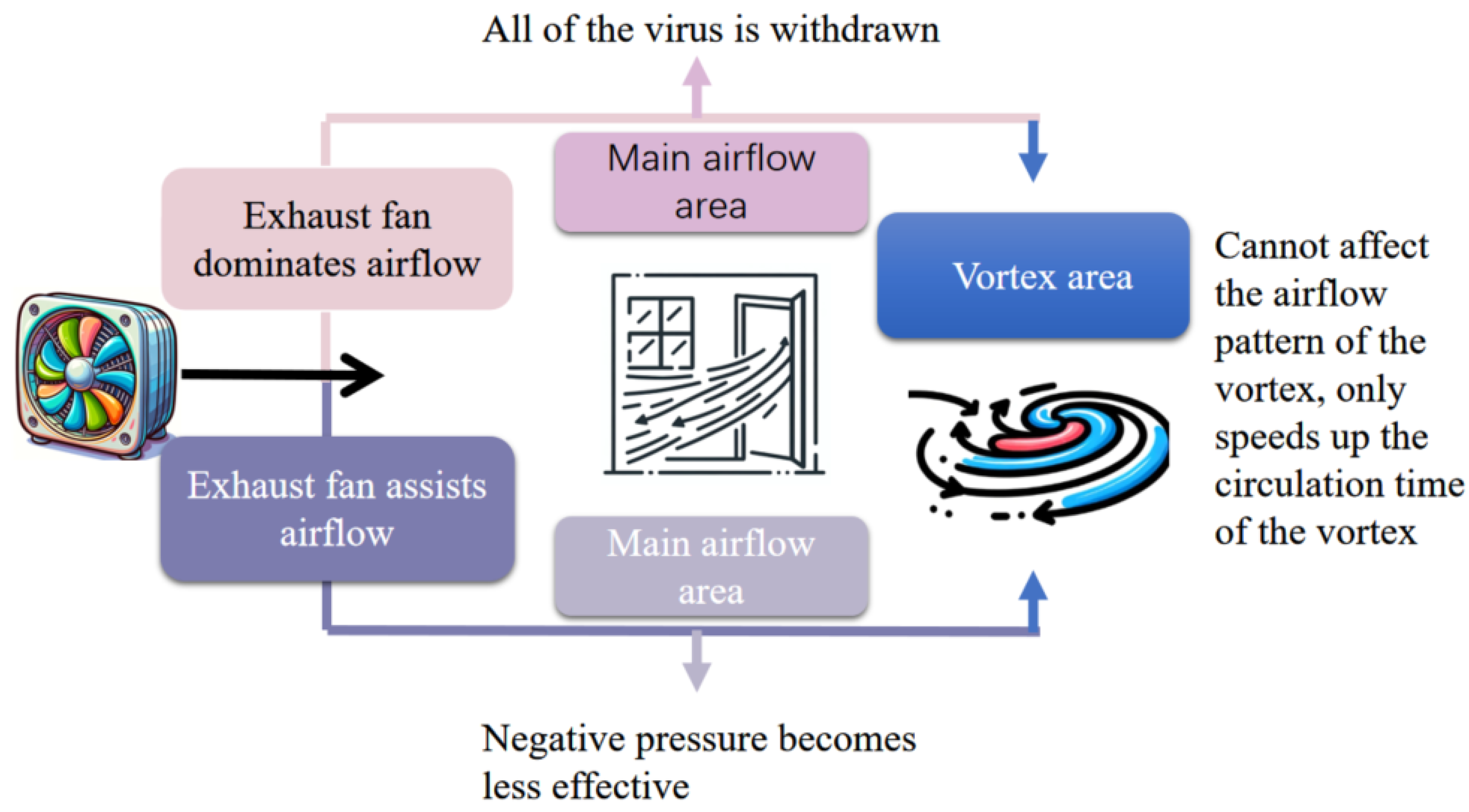
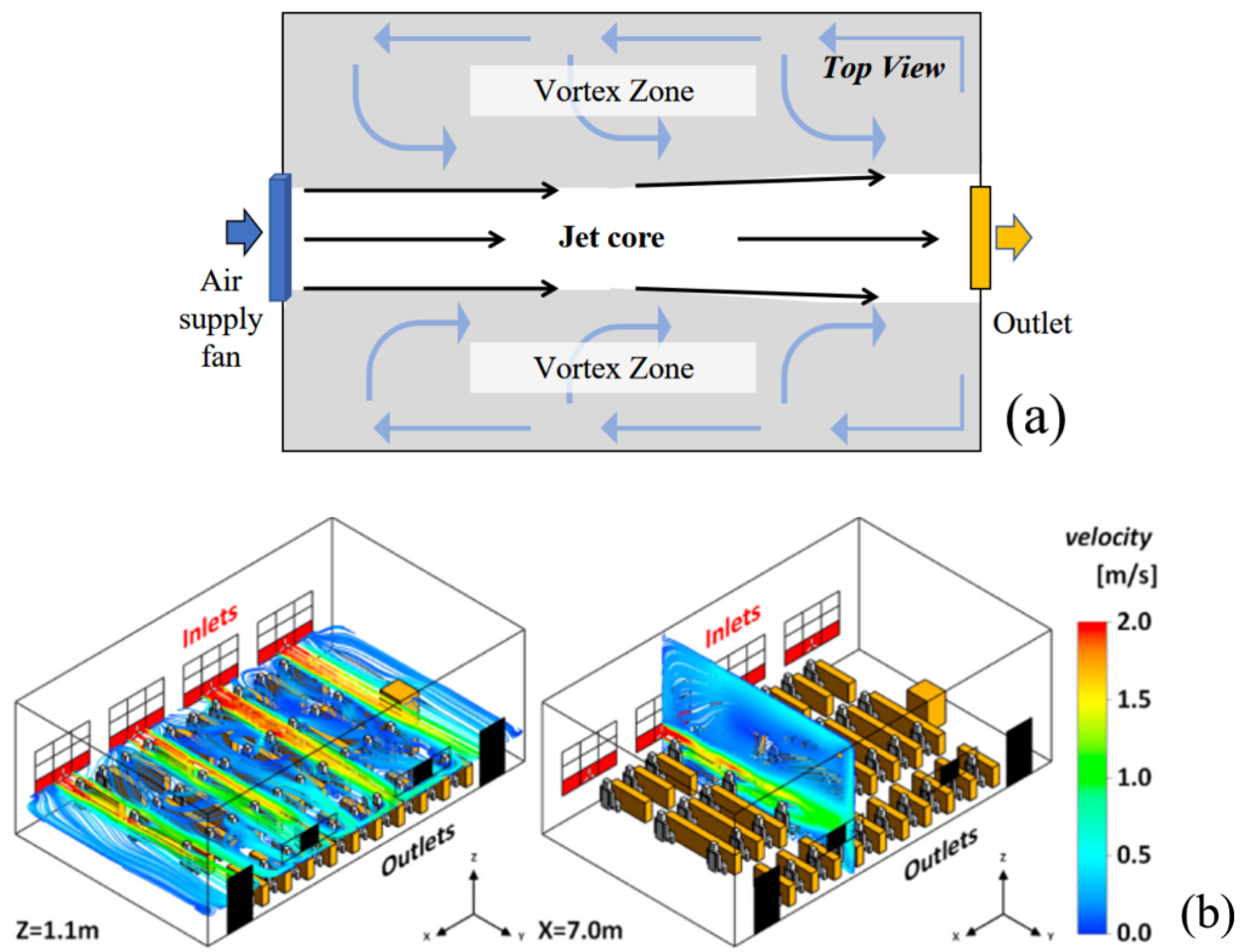

| Ref. | Location | Size (m3) | Environmental Temperature (°C) | Rotation Speed (RPM) | Number of CF | Particle Size Range | Method | Conclusions Related to Particle Size | Conclusions Related to the Breathing Zone/Whole Room |
|---|---|---|---|---|---|---|---|---|---|
| [36] | Residential | 38 | - | 160 265 365 | 1 | Large particles: >35 μm Small particles: <35 μm | CFD | Increased rotational speed benefits the settlement of large-particle viruses, but not the settlement of small particle viruses. | In whole rooms, CFs combined with natural ventilation and masks are beneficial for reducing the spread of viruses in indoor spaces. |
| [12] | Classroom | 278 | 27 ± 0.5 | 0 100 140 | 4 | 5–10 μm | Tracer experiment and CFD | - 1 | Increasing RPM 0 to 140 decreases the breathing zone concentration by 21%. |
| [51] | Classroom | 278 | 26.5 | 0 100 | 4 | 0–30 μm | Tracer experiment and CFD | The fan facilitates the settling of particles that are >15 μm. | Concentrations in the breathing zone are decreased by at least 87%. |
| [37] | Factory | 39,100 | Summer: 32, Winter: −17.5 | 0 16 78 | 1 (BIG 2) | 0.5–10 μm | CFD | - | Rotating downward CFs at high speeds facilitate dilution of virus concentration. |
| Ref. | Location | Size (m3) | Ceiling Fan Setup | Method | Conclusion of Ceiling Fan Rotating Upwards | Conclusion of Ceiling Fan Rotating Downwards |
|---|---|---|---|---|---|---|
| [37] | Factory | 39,100 | ① UP ② DOWN | CFD | Upward rotation is unfavorable | The best conditions are when operating at the highest rpm |
| [48] | Laboratory | 30 | ① UP ② DOWN | Tracer experiment | Uniform airflow in the room | High impact on indoor airflow, not uniform |
| [49] | Hospital | 42 | ① UP ② DOWN | CFD | Upward rotation (RPM 107) in combination with the UR-UVGI system facilitates virus removal | None of the working conditions are favorable |
| [38] | Hospital | 41.6 | ① UP ② DOWN | CFD | Combined with the UR-UVGI system, the system facilitates virus removal | When the fan (235 rpm) was blowing downward, the residual virus particles increased |
Disclaimer/Publisher’s Note: The statements, opinions and data contained in all publications are solely those of the individual author(s) and contributor(s) and not of MDPI and/or the editor(s). MDPI and/or the editor(s) disclaim responsibility for any injury to people or property resulting from any ideas, methods, instructions or products referred to in the content. |
© 2025 by the authors. Licensee MDPI, Basel, Switzerland. This article is an open access article distributed under the terms and conditions of the Creative Commons Attribution (CC BY) license (https://creativecommons.org/licenses/by/4.0/).
Share and Cite
Han, X.; Mahyuddin, N.; Qin, M.; Wang, P.; Zhang, C.; Wei, Y.; Pan, S. Effect of Different Mechanical Fans on Virus Particle Transport: A Review. Buildings 2025, 15, 303. https://doi.org/10.3390/buildings15030303
Han X, Mahyuddin N, Qin M, Wang P, Zhang C, Wei Y, Pan S. Effect of Different Mechanical Fans on Virus Particle Transport: A Review. Buildings. 2025; 15(3):303. https://doi.org/10.3390/buildings15030303
Chicago/Turabian StyleHan, Xiaofei, Norhayati Mahyuddin, Mingyuan Qin, Puyi Wang, Changchang Zhang, Yixuan Wei, and Song Pan. 2025. "Effect of Different Mechanical Fans on Virus Particle Transport: A Review" Buildings 15, no. 3: 303. https://doi.org/10.3390/buildings15030303
APA StyleHan, X., Mahyuddin, N., Qin, M., Wang, P., Zhang, C., Wei, Y., & Pan, S. (2025). Effect of Different Mechanical Fans on Virus Particle Transport: A Review. Buildings, 15(3), 303. https://doi.org/10.3390/buildings15030303





